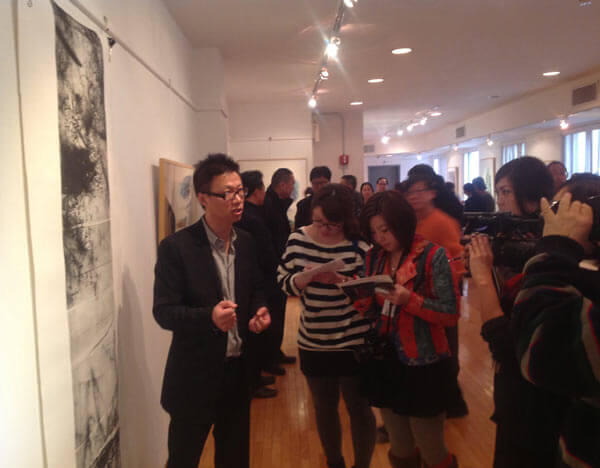By Kevin Zimmerman
Shanghai artist Zhang Lanjun fuses traditional Chinese art with modern abstract creations served up via a Western palate.
Lanjun, 51, whose first solo American show, Still Waters Run Deep, is running through Feb. 11 in Flushing, is one of only a few Eastern artists who creates prints through the process of carving designs onto a copperplate using a knife or other sharp object.
“If you use a brush, the brush is too soft,” Lanjun said. “And I like the process. There’s an enjoyment from the direct carving. It’s a passionate expression of my inner feelings.”
This method, called the dry-point technique, has been used for hundreds of years to create coins and to develop molds for printing paper money, said Q. X. Wang, president of the Contemporary Artists and Critics Association and the New York Modern and Contemporary Art Research Institute, who served as Lanjun’s interpreter during a recent dinner at Red House Restaurant in Fresh Meadows. But as a method of creating art, dry-point is a fairly new development.
As a student at Beijing’s Central Academy of Chinese Art, Lanjun studied the works of the great Western masters and was taught the thousand-year-old traditions of print making, using the usual wood block carvings on silk screens.
Not surprisingly Lanjun’s early works adhered to the rules of realism, Wang said. He created sheets and sheets of paper depicting Chinese landscapes with craggy mountaintops covered in white snow.
Then, about 16 years ago, he happened to pick up a copper plate, which shook up his methods and helped him to create pieces using a new form of artistic language.
“I enjoyed the feeling of carving on the metal plates,” Lanjun said. “It was very close to drawing with a pencil onto paper.”
It can take up to a week for Lanjun to complete a plate as he carves each single line of the design using a tool with a point no bigger than a needle, Wang said. And taking a cue from the pointillists, Lanjun even spent a year carving a design dot by dot onto one of his molds.
“He invented the technique,” Wang said. “It was maybe more than 1 million dots carved.”
Once finished with a carving, Lanjun then applies ink to the mold before pressing it onto a heavy stock paper that he buys from a French company.
He has even developed his own style of inking, Wang said.
Rather than creating two plates, one for black ink and the other for the colored liquid, Lanjun sparingly applies both types of ink to each plate, thereby creating a print with black and white portions accented by bursts of low-key colors.
The finished projects resemble traditional Chinese watercolors, including designs that mimic typical brush strokes, but any likeness to realistic landscapes is purely coincidental, Wang said.
“It is all abstract,” Wang said. “He feels, compared with realism, abstraction is a more effective vehicle to express his internal feelings and emotions. Realism belongs more to the classics than the contemporary.”
It’s this adherence to tradition but broken down and recreated through an abstract eye that made Lanjun the obvious choice to star in the Contemporary Artists and Critics Association’s first solo show.
Lanjun is showing 22 of his pieces of multiple sizes that were created using various techniques and methods, but each clearly falls within the current definitions of contemporary.
Of course, that doesn’t mean Lanjun isn’t interested in refining those definitions as he continues to create.
“In his mind,” Wang said, “the supreme aim is to apply the simpliest vocabulary to express the most profound emotions.”
If you go
Still Waters Run Deep
When: Through Tuesday, Feb. 11
Where: The Gallery of Amerasia Bank, 41-02 Main St. Second Floor, Flushing








































